As the year draws to a close, now is a good time to take stock of the financial ups and downs of 2019. This year’s annual income survey saw optometrist participation grow to nearly 900 respondents who shared that their income rose, albeit incrementally, over the past year to an average of $170,341—an increase of almost 1% from 2018. While this is good news for the profession, this year’s rate is the lowest it’s been in the last five years: it was 9% from 2015 to 2016, 4% from 2016 to 2017 and 3% from 2017 to 2018. Hopefully 2020 will turn the tide of this downward trend.
This year’s survey was comprised of slightly more part-time participants than last year’s, making up 11% of the total respondents compared with 9% in 2018. Those 11% also fared better than their full-time colleagues this year. Full-time workers averaged an income of $175,765 in 2019—a mere 0.35% rise over the last year—and part-timers made $127,185 on average, an 11% surge from 2018.
As always, be mindful that while we ask the same survey questions, the responses we compare from year to year come from different individuals, making trend analysis tricky, especially among a smaller cohort. The results are representative of the profession but aren’t as accurate as they could be.
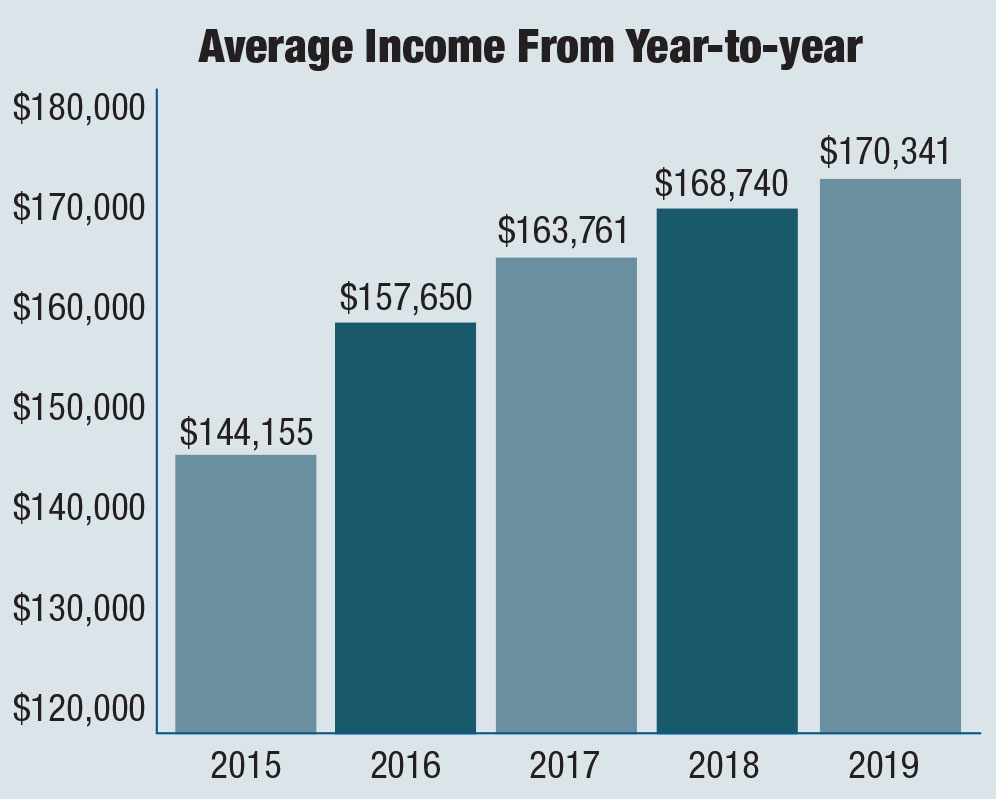 |
| Click image to enlarge. |
The More the Merrier
Years of experience and money made almost always coincide, and this year was no different. Entry-level respondents with zero to 10 years of experience comprised 35% of this year’s survey participants and earned an average of $144,013, a 10% jump from the average income beginners made in 2018.
The average income leap from the first experience bracket to the next one, 11 to 20 years (23% of respondents had this intermediate level of experience), was a sizable 18% to $170,180. This also represents a 3% increase from 2018.
Financial progress stalled a bit for those with 21 to 30 years of experience who experienced a mid-career plateau. These clinicians made up 21% of respondents and earned an average of $176,555, just 4% more than those with 11 to 20 years of experience. It’s also a less-than-desirable 11% decrease from the average income this experience group reported in 2018.
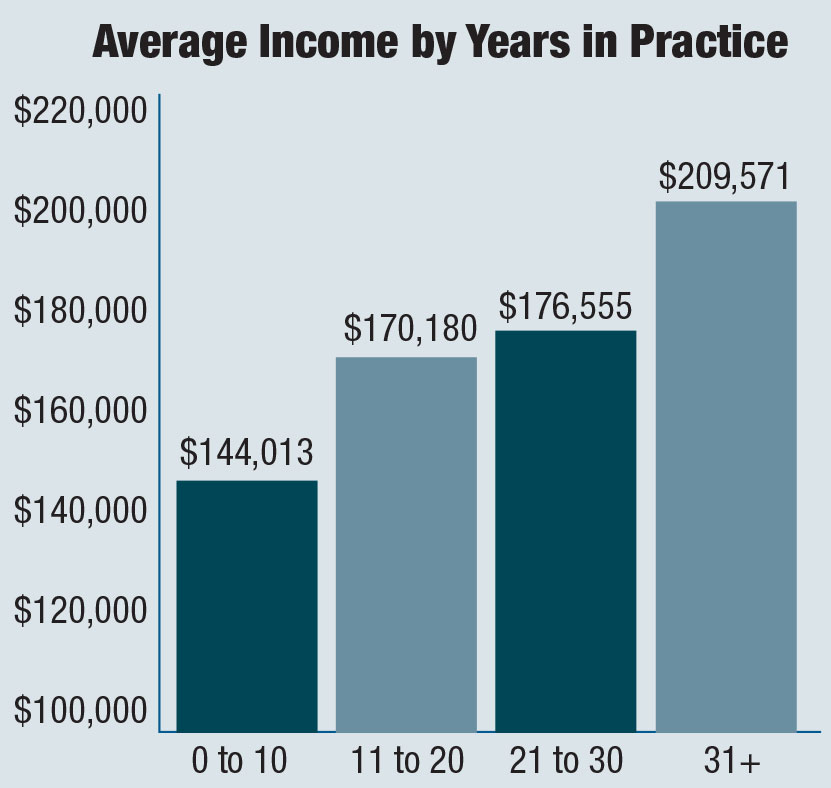 |
| Click image to enlarge. |
While last year’s seasoned clinicians made less than their counterparts with slightly fewer years of experience, this year’s 21% of participants who have been practicing for more than 30 years earned an average of $209,571. That’s a 19% jump for 10 more years of experience and a 7% increase from the average income veterans reported in 2018. While not all optometrists at different experience levels were on the right track, this group certainly was—a testament that all the years you put in do pay off.
In Charge and Living Large
Working for yourself is the dream for many. For survey respondents, it’s also a profitable dream. While the majority of respondents (57%) are employed, those who are self-employed came out on top in 2019, earning an average of $220,206, a 66% increase from those who are employed ($132,967 on average)—similar to the 67% difference between the two categories last year. While this is a significant monetary gap, both groups saw their average income rise from 2018, with employees making 3% and self-employed workers making 2% more than last year.
Of those who are employed, 52% work for another OD or MD, 21% for a commercial firm, 9% for a hospital/VA, 6% for an HMO or a PPO and 5% for a university. Seven percent of respondents chose the “other” option and reported taking the military, government, industry, nonprofit or private equity route, to name a few. These percentages were similar to last year’s.
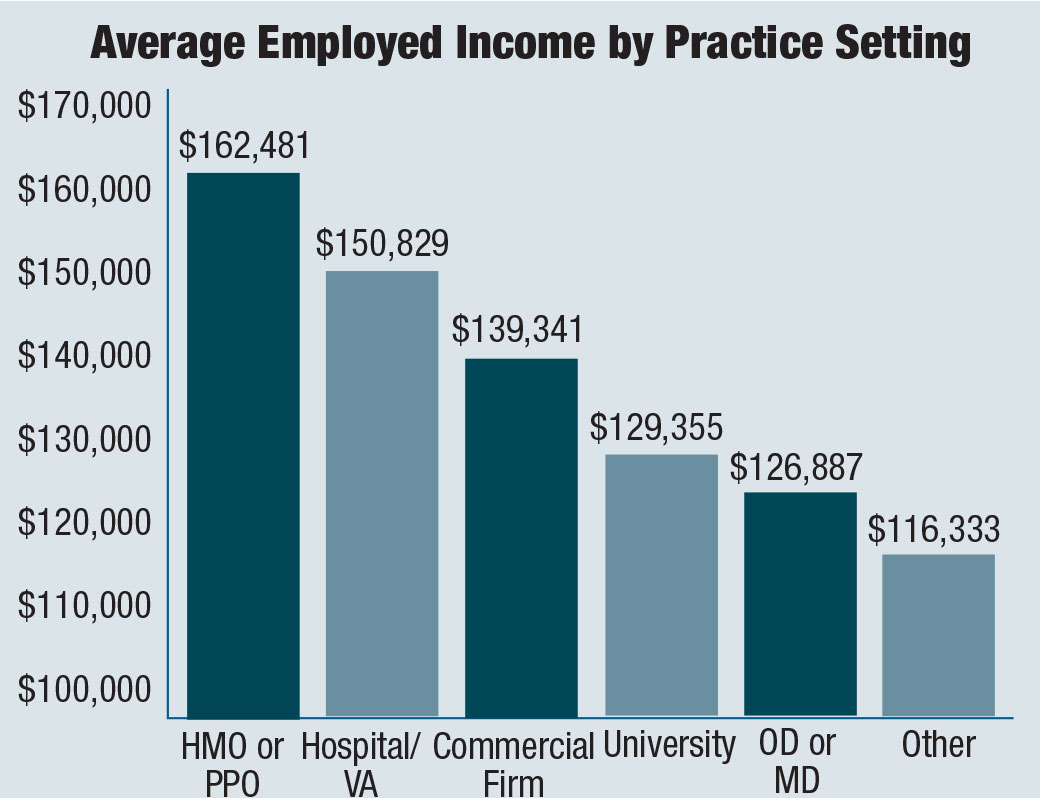 |
| Click image to enlarge. |
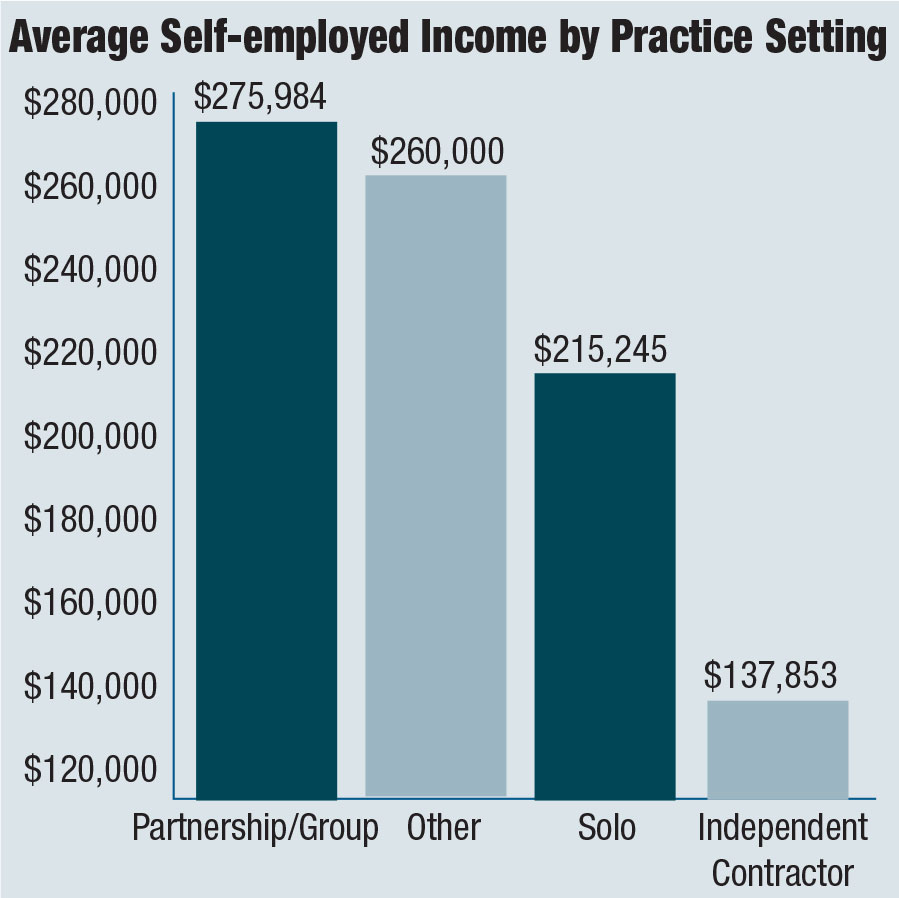 |
| Click image to enlarge. |
Employees who chose the “other” option were the least profitable, making an average of $116,333 in 2019. This category fell a few ranks compared with last year’s results.
Similar to the last two years, working for another OD or MD ($126,887) or a university ($129,355) were lower-paying gigs. Those who work for a commercial firm earned $139,341 on average—comparable with 2018. Moving up from the least profitable work environment last year, those employed by a hospital/VA made an average of $150,829 in 2019.
At the top of the employed chain for another year in a row were HMO or PPO employees who made an average of $162,481—level with the average income their counterparts earned in 2018.
On the other hand, looking at those who are self-employed, 54% practice on their own, 29% are members of partnerships or groups and 16% are independent contractors. Less than 1% chose the “other” option.
As it was the past two years, working as an independent contractor was the least profitable option and only paid an average of $137,853 in 2019. Those who work on their own made $215,245 on average—a 10% boost from last year. The only respondent who chose the “other” option owns a franchise and earned an average of $260,000 this year.
Rising above the rest in 2019 were self-employed optometrists who work in partnerships or groups, making an average of $275,984, up 4% from 2018.
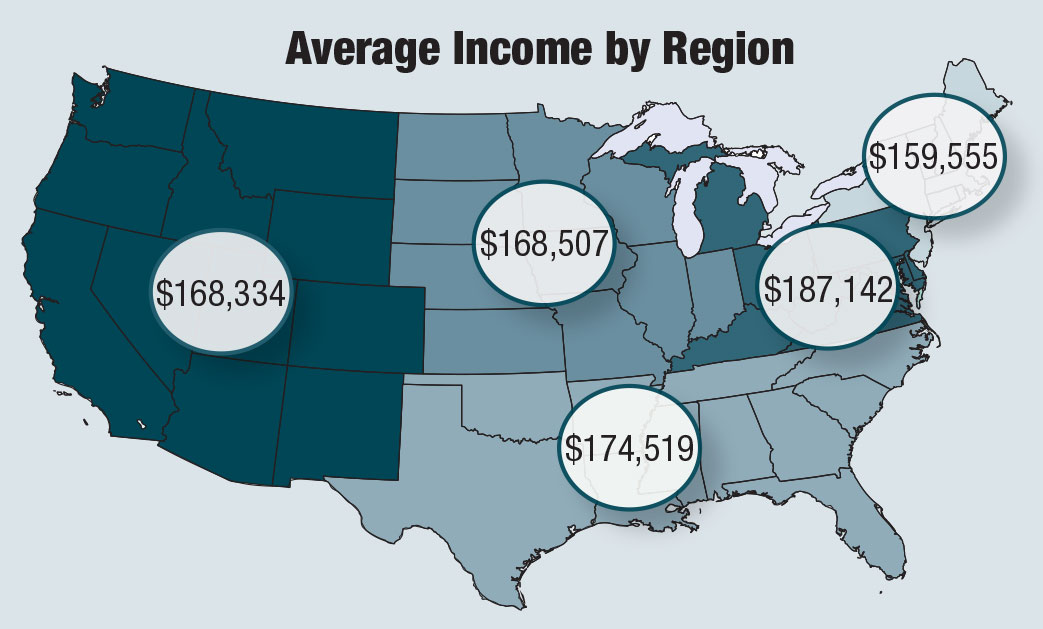 |
| Click image to enlarge. |
If the Price is Right, Hop on a Flight
While moving comes with its own baggage—literally—it might be worth it if you could make 17% more by calling a new place home.
Shaking things up, the Mid-Atlantic/Lower Great Lakes region was this year’s most lucrative place to practice, with workers earning an average income of $187,142, 18% more than respondents from this part of the country claimed in 2018.
Earning an average of 7% less than those in the highest-paying region, practitioners in the South were bumped down to the next highest income—$174,519 on average, 8% less than 2018.
Neck-and-neck for the third and fourth most profitable areas of the country, respectively, were the Midwest ($168,507) and the West ($168,334), earning right around what they made last year. Practitioners in the Northeast were once again the least profitable, only making an average of $159,555. However, this still represents a 4% rise from the average income reported in this region in 2018.
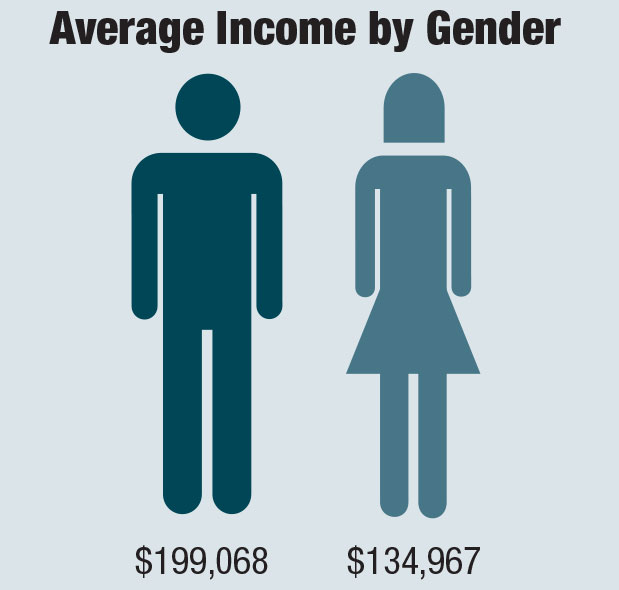 |
| Click image to enlarge. |
Gender Gap Grapple
The gender income gap has been a topic of conversation and controversy for as long as men and women have been in the workforce together. While progress has been made across the board—the disparity between men and women closed by 3% last year—it hasn’t been enough to keep optometry from moving backward. Not taking full-time or part-time into account, men made 47% more than women in 2019, which means the gap widened by 10% over the past 12 months.
This year, men out-earned women on average $199,068 to $134,967 and made up the majority of respondents at 55%. Further distancing both groups, men made 4% more than their counterparts did in 2018 while women made 3% less.
At an average income of $223,909—18% more than last year—men who have been practicing for more than 30 years earned 70% more than women at the same experience level, who sat at $131,632 on average, 2% less than last year. This represents another substantial step backwards for the category as a whole—the gap widened from 10% in 2017 to 42% in 2018 and by a similar amount this past year. This is the largest income disparity between men and women at each experience level in 2019.
The next highest income gap was between men and women with 21 to 30 years of experience. Men earned an average of $203,165, 50% more than women with the same level of experience, who reported an average income of $135,251. This widening gap—it was 12% in 2018—looks even worse when we throw in comparisons of what men and women with 21 to 30 years under their belts earned between last year and this year—13% more and 16% less, respectively.
The income difference between men and women with 11 to 20 years of experience was similar at 47%, with men earning an average of $204,456 and women, $139,560. This disparity is up from 40% last year, with men making a similar income and women seeing theirs drop by 4% compared with 2018.
The less experience, the less disparity, this year’s survey found. The smallest income disparity, 21%, belonged to novices with zero to 10 years in the field, with men earning $161,088 on average and women, $132,628. The men reported making 9% less than 2018 and the women, 6% more, closing the gap by 20% over the last year.
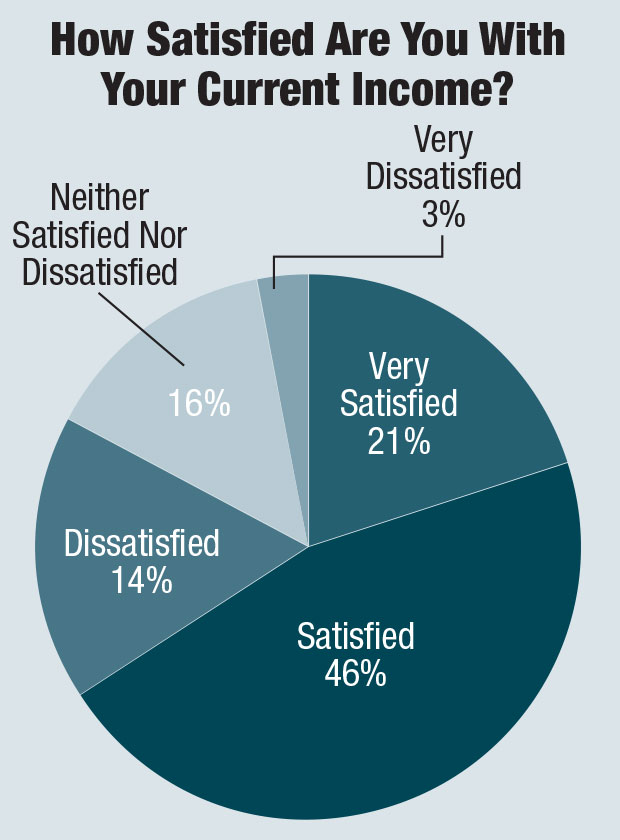 | 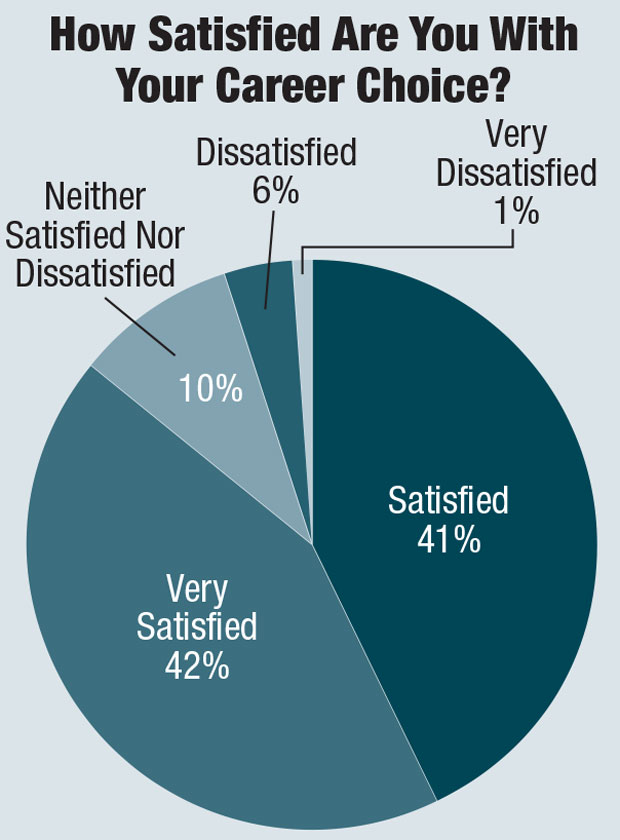 |
| Click images to enlarge. | |
Looking at the Bigger Picture
With this year’s financial results in the books, the majority of respondents seemed to be in good spirits, as more than 65% reported feeling satisfied or very satisfied with their income for the second year in a row. Respondents generally agreed that the amount of money they make is commensurate with their work and worth. Their annual take-home also gives them flexibility and security in their daily lives, lets them save for retirement and allows them not to worry about the future. Many believe the income they earn as an optometrist is the reason they’re able to live comfortably, with one respondent saying it “allows me to have a quality of life I’m very satisfied with.” Recent graduates reported that they are making more than they expected and are pleased with the field’s profitability.
Keeping up with the generally positive attitude, almost 85% of respondents indicated they were satisfied or very satisfied with their career choice. Most named the income they make, the work-life balance they are able to strike and the opportunities available to them as the best benefits of the job. The majority said helping make a difference in others’ lives is the greatest perk of all. “I decided to become an optometrist when I was 12 years old—it’s all I’ve ever wanted to do,” said one respondent.
However, some do not believe they are bringing in nearly as much as they should be with the amount of effort they put into their job and their experience level. These practitioners said they are concerned about their ability to pay off loans and the lack of raises or bonuses they’ve seen thus far in their careers. “It is getting harder and harder to grow a practice with all the administrative challenges, pressure from online competitors and increased staffing costs,” a respondent said.
Many are not pleased with the push to see more patients and run more tests, the cost of getting started in the profession in the first place and the ever-changing insurance requirements, with one respondent calling optometrists “glorified salesmen.” Others stated the profession is becoming too commercialized and it’s no surprise that it’s losing respect. “Optometry has been great to me. However, I’m glad I’m retiring. I do not feel like the changes coming in the future, especially government involvement, will be pleasant,” another remarked.
While there were some who expressed dissatisfaction, the percentages fell as the rankings became more pessimistic toward how respondents felt about their income and career choice—good signs all around—and many remained optimistic about the year to come. Of this year’s respondents, 53% expect their income to increase, 40% don’t expect a change at all and only 7% expect it to decrease in the future.
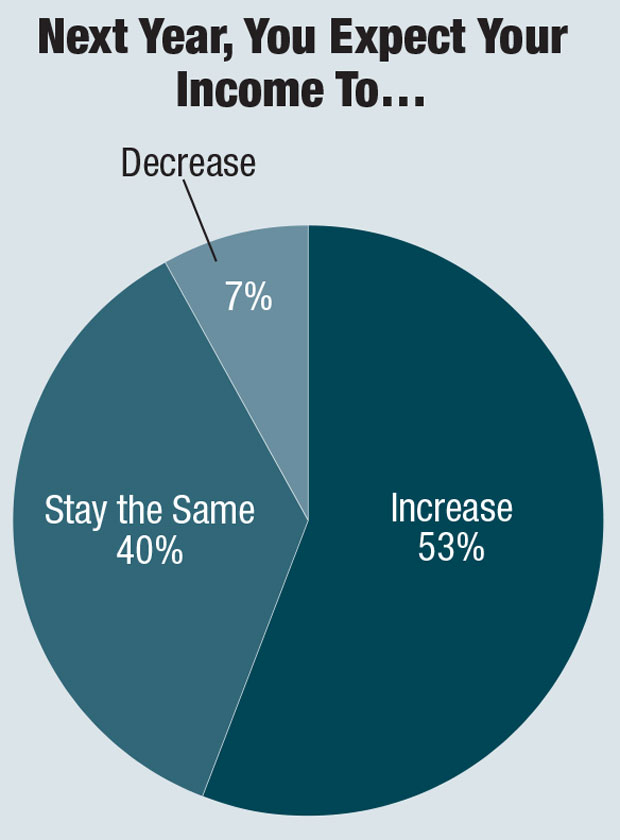 |
| Click image to enlarge. |
Eyes on the Prize
As is usually the case, some optometrists did better than others in 2019, keeping in mind factors like experience level, employment status, location and gender. We saw the mid-career plateau reappear and the gender income gap widen. The upside is that the average income continues to increase.
And optometrists are a resourceful bunch never shy of a challenge. To propel the field forward and boost their salary, many respondents have plans to increase patient awareness and volume through marketing and referrals and improve efficiency and accuracy through remodeling and staff additions. Others want to invest in equipment, specialize and expand their locations and services.

